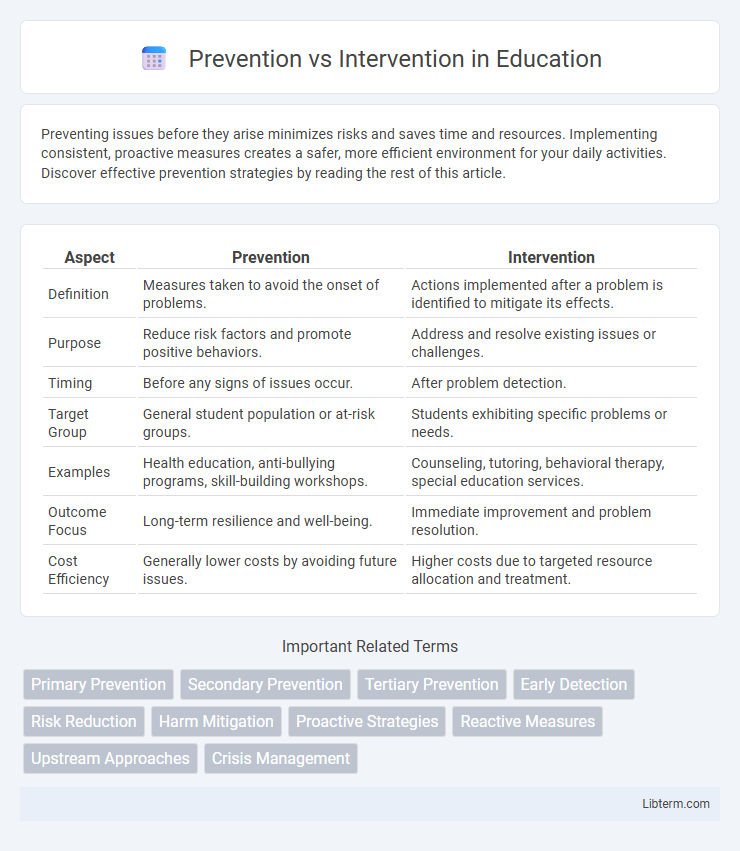Preventing issues before they arise minimizes risks and saves time and resources. Implementing consistent, proactive measures creates a safer, more efficient environment for your daily activities. Discover effective prevention strategies by reading the rest of this article.
Table of Comparison
| Aspect | Prevention | Intervention |
|---|---|---|
| Definition | Measures taken to avoid the onset of problems. | Actions implemented after a problem is identified to mitigate its effects. |
| Purpose | Reduce risk factors and promote positive behaviors. | Address and resolve existing issues or challenges. |
| Timing | Before any signs of issues occur. | After problem detection. |
| Target Group | General student population or at-risk groups. | Students exhibiting specific problems or needs. |
| Examples | Health education, anti-bullying programs, skill-building workshops. | Counseling, tutoring, behavioral therapy, special education services. |
| Outcome Focus | Long-term resilience and well-being. | Immediate improvement and problem resolution. |
| Cost Efficiency | Generally lower costs by avoiding future issues. | Higher costs due to targeted resource allocation and treatment. |
Understanding Prevention and Intervention
Prevention involves proactive measures designed to stop problems before they start by addressing risk factors and promoting protective behaviors across populations. Intervention focuses on timely, targeted actions to manage and mitigate existing issues, aiming to reduce negative outcomes and support recovery. Understanding prevention and intervention requires recognizing their complementary roles in health and social systems to effectively allocate resources and improve overall outcomes.
Key Differences Between Prevention and Intervention
Prevention targets reducing the occurrence of problems before they arise by addressing root causes and risk factors, often through education and policy changes. Intervention involves responding to existing issues with tailored support, treatment, or strategies to mitigate harm and promote recovery. The key difference lies in timing: prevention acts proactively while intervention responds reactively to established conditions.
The Role of Prevention in Health and Well-being
Prevention plays a critical role in enhancing health and well-being by reducing the incidence of chronic diseases and lowering healthcare costs through early risk factor management. Effective preventive measures, such as vaccination programs, lifestyle modifications, and regular health screenings, contribute to improved population health outcomes and increased life expectancy. Emphasizing prevention promotes a proactive healthcare approach that supports sustainable health systems and reduces the burden on medical intervention services.
Early Intervention: When and Why It Matters
Early intervention is critical within the first few years of childhood, as it addresses developmental delays and disabilities before they become more entrenched. Timely support services enhance cognitive, social, and emotional outcomes, reducing long-term educational and healthcare costs. Implementing early intervention programs in healthcare and education systems promotes better lifelong opportunities and overall quality of life.
Benefits of Prioritizing Prevention Strategies
Prioritizing prevention strategies reduces long-term costs by addressing root causes before issues escalate into complex problems requiring costly interventions. Early prevention improves population health outcomes, decreases the burden on healthcare systems, and enhances overall quality of life. Effective prevention programs lead to sustainable social and economic benefits by minimizing the incidence of chronic diseases, mental health disorders, and other preventable conditions.
Challenges in Implementing Prevention Programs
Challenges in implementing prevention programs include limited funding, lack of community engagement, and insufficient training for staff. Cultural barriers and resistance to change can reduce program effectiveness, while difficulties in measuring long-term outcomes hinder progress assessment. Coordination among stakeholders and sustaining program momentum also pose significant obstacles to successful prevention efforts.
Measuring the Effectiveness of Intervention Approaches
Measuring the effectiveness of intervention approaches relies on quantifiable outcomes such as reduced incidence rates, improved behavioral metrics, and cost-benefit analyses compared to baseline data. Data collection methods include randomized controlled trials (RCTs), longitudinal studies, and pre-and post-intervention assessments to capture both short-term impact and sustained change. Evaluating intervention effectiveness also involves monitoring adherence rates, patient satisfaction, and real-world applicability to ensure scalable and evidence-based solutions.
Case Studies: Prevention vs Intervention in Practice
Case studies in prevention versus intervention reveal varied outcomes across health and social sectors, highlighting prevention's cost-effectiveness and long-term benefits in reducing disease incidence and social issues. Intervention approaches often demonstrate critical impacts in crisis management, offering immediate relief and tailored support to individuals in urgent need. Analyzing these case studies emphasizes the importance of integrating both strategies to optimize resource allocation and enhance population health and well-being.
Integrating Prevention and Intervention for Optimal Outcomes
Integrating prevention and intervention strategies fosters optimal outcomes by addressing health and social issues at multiple stages, reducing the incidence and severity of problems. Implementing evidence-based prevention programs alongside timely, targeted interventions ensures comprehensive support tailored to individual and community needs. This holistic approach enhances overall well-being, decreases long-term costs, and improves resource allocation across healthcare and social services sectors.
Future Perspectives: Balancing Prevention and Intervention
Future perspectives in balancing prevention and intervention emphasize integrating predictive analytics and personalized health strategies to optimize resource allocation and improve outcomes. Advances in artificial intelligence enable early identification of at-risk populations, shifting focus towards proactive measures while ensuring timely intervention for acute cases. This balanced approach enhances public health resilience by combining data-driven prevention with adaptive intervention protocols.
Prevention Infographic

 libterm.com
libterm.com